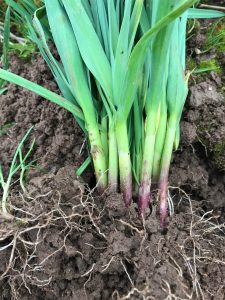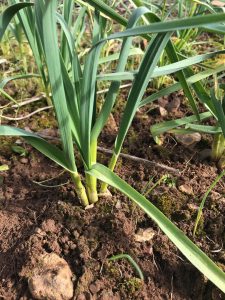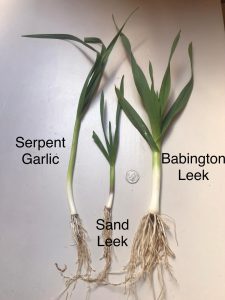Your wheelbarrow is currently empty!
Perennial Alliums – Sand Leek, Serpent Garlic as alternatives to Babington Leek
There are several varieties of perennial allium – each flowering from July – August, if not harvested – then forming a head of small bulbils that will fall onto the soil to send up yet more plants next year. The following examples are all very low maintenance, hardy and very tasty! Probably the most known about and sought after is the Babington Leek. However, there are other worthy examples, two of which I’d like to take a closer look at here.
 First off we have the Sand Leek – Allium scorodoprasum (Not to be confused with Allium sativum v. ophioscoroson – the Serpent Garlic – both of which also go by the name Rocombole). Sand Leek produces edible stems that can be cut at ground level to then regrow and clusters of bulbils (above ground on looping stems) which can both be used as a mild garlic substitute. Young leaves can also be cut and used as chives. What first struck me about this plant was how quickly it seemed to ‘clump up’ compared to either the Babington or Serpent Garlic. These examples may be slightly smaller than their counterparts but what they lose in size, they certainly make up for in quantity.
First off we have the Sand Leek – Allium scorodoprasum (Not to be confused with Allium sativum v. ophioscoroson – the Serpent Garlic – both of which also go by the name Rocombole). Sand Leek produces edible stems that can be cut at ground level to then regrow and clusters of bulbils (above ground on looping stems) which can both be used as a mild garlic substitute. Young leaves can also be cut and used as chives. What first struck me about this plant was how quickly it seemed to ‘clump up’ compared to either the Babington or Serpent Garlic. These examples may be slightly smaller than their counterparts but what they lose in size, they certainly make up for in quantity.
Taste test: Raw – Leaves: mildly, pleasantly garlicky – Stem: very garlicky! Cooked – Mild, pleasant garlic flavour
Conclusion: Prolific clumping, nice sized stems, very nice flavour and good sized, plentiful bulbils

Next up we have Serpent Garlic (Allium sativum v. ophioscoroson). It produces attractive looping stems with heads of bulbils in summer that will eventually drop and produce new plants. Plants will clump up more each year but slower than Sand Leek. Serpent Garlic will eventually produce an underground bulb up to 6cm diameter but it is recommended to let the plant grow on for a couple of seasons in order to achieve this. Edibility – Bulb can be dug up and eaten raw or cooked. Bulbils – raw or cooked – they have a strong garlic flavour, though they are a total faff to peel. Leaves – raw or cooked. Chopped and used in salads, they are milder than the bulbs. Young stems – recommend cooked.
Taste test: Raw – Leaves: mildly garlicky – Stem: very strong garlic Cooked – Leaves: very mild garlic – Stem: very sweet excellent garlic flavour
Conclusion: A slow grower if you are wanting bulbs and bulbils are fiddly but an excellent tasting stem and clumps up nicely.

Babington Leek (Allium ampeloprasum) Also sends up flowering heads in summer that ripen to heads of nice sized bulbils. All parts of this versatile plant are edible. Although it is best to leave for first season to allow them to bulk up. Harvesting time is usually around March to June. The whole leek can be cut off above the bulb which will regrow. Best to do this before they send up flowering stalk. Leaves can be harvested and have a garlicky flavour. Great in soups, cooked foods, salads, you can also pickle the bulbils. Over the years, as the leeks clump up, they can be thinned and replanted (or eaten!)
Taste test: Raw – Leaves: Oniony not unpleasant – Stem: Strong onion flavour Cooked – Leaves: mild onion – Stem: Excellent mild, creamy sweet onion flavour
Conclusion: Very good sized stems, excellent cooked flavour, plentiful good sized bulbils.
